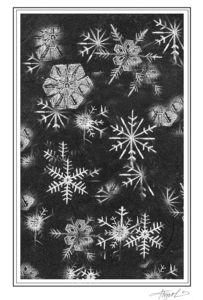By Frank Kaczmarek
Wilson Bentley (1865-1931) lived his entire life in Jericho, Vermont, where he developed a passion for snowflakes at an early age. He started by collecting snowflakes and trying to create detailed drawings of each one, but the snow crystals’ tiny size and the speed at which they melted made this a futile task. At age 15, with a microscope given to him by his mother, Bentley began experimenting with photography as a means of capturing the elusive design of a snowflake.

Four years later, after much trial and error, he produced the first photograph of an individual snowflake. Over the next 47 winters, Bentley produced more than 5,000 photographs of individual snowflakes. More than 2,400 of his images were published in 1931 in a book titled “Snow Crystals,” which remains in print today, earning the farmer the affectionate moniker “Snowflake” Bentley.
“Under the microscope, I found that snowflakes were miracles of beauty,” Bentley wrote in 1925. “Every crystal was a masterpiece of design and no design was ever repeated.”
He was the first to assert, based on his thousands of photographs, that no two snowflakes are identical, although they may have shared similarities. With co-author George Henry Perkins of the University of Vermont, Bentley published an article arguing this point. It caught the public’s attention, but was it true?
A snowflake begins when water vapor high in the atmosphere condenses on a particle of dust or pollen, then freezes into a tiny ice crystal. This initial crystal acts as a seed from which the snowflake grows. The crystal reflects the shapes of the molecules that form it. All snowflakes have a hexagonal, or six-sided, shape but exhibit unique geometries — from flat, plate-like prisms to elaborate branching structures. These differences are due to minute variations in temperature and humidity the growing crystal encounters during its fall to earth.
Most meteorologists agree it is incredibly unlikely that two snowflakes would experience identical conditions at the microscopic level as they travel downward, and so — in theory — accept Bentley’s belief that no two snowflakes are alike.
Icelandic chemist Tryggvi Emilsson, inspired by Bentley’s snowflake photographs, wanted to go one better: to preserve the actual snow crystal so that it could be viewed even in the middle of a summer heat wave or serve as a pleasant memory years later. He devised a simple method of preservation that employed a common, everyday household item, superglue. He made his first snowflake “fossil” in 1979.
To preserve a snowflake using Emilsson’s method you’ll need the following items: snow (which we usually have in abundance during a Northeast winter), some glass microscope slides and coverslips (readily and cheaply obtained on the internet), a piece of black or dark blue cloth or construction paper for collecting the snowflakes, a small artist paintbrush, and a bottle of liquid superglue (the gel version of superglue will not work).
To keep all of these items cold until they are needed, I store them in a plastic box in my freezer. When you’re ready to begin, allow the snow crystals to collect on the cloth or construction paper. Select an interesting specimen, gently pick it up with the artist paintbrush, and carefully place it on a microscope slide. Do not handle the microscope slide, as heat from your hand or breath could damage or melt the snowflake. Carefully place a drop of cold superglue on the crystal. This may take some practice: placing the nozzle of the glue bottle too close or too far away from the snowflake could cause damage. Lay the coverslip gently (and quickly) on top of the glue drop. If glue bubbles occur try angling the coverslip onto the drop. The glue fully hardens at a slow rate, so either place the slide(s) in a sheltered spot outside or in your freezer for five to 10 days.
After the glue has fully hardened, I display my best efforts with a mat and frame and pass these preserved snowflakes on to family and friends.
Frank Kaczmarek is a photographer and retired biologist and author of “New England Wildflowers: A Guide to Common Plants,” a Falcon Field Guide published in 2009 by Globe-Pequot Press. He lives in Lyman, New Hampshire. Illustration by Adelaide Murphy Tyrol. The Outside Story is assigned and edited by Northern Woodlands magazine and sponsored by the Wellborn Ecology Fund of the New Hampshire Charitable Foundation: nhcf.org.




